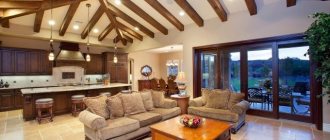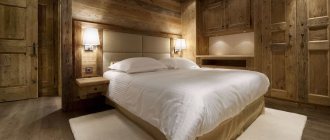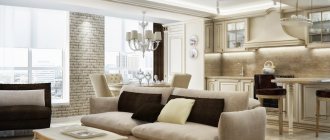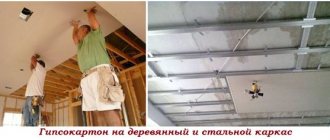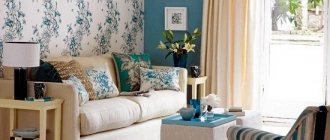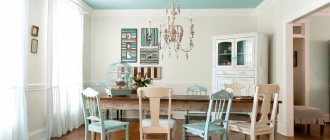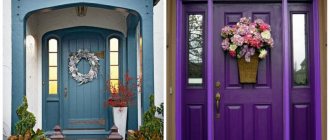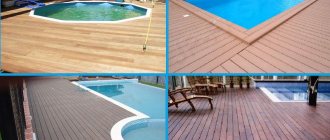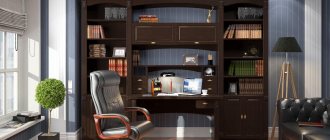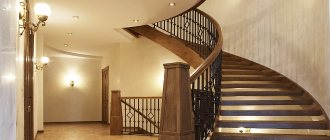Finishing the ceiling in a wooden house can be done in different ways. A large number of options that are not available for an apartment will look very appropriate and harmonious in a private house. And this is due to the fact that the ceilings here are often higher than in apartments, and also due to the configuration of the roofs, they can have original shapes, which allows you to develop your own unusual design.
Independent work on covering the ceiling in a wooden house requires certain knowledge and skills. The specifics of the work will depend on the type of ceiling. Thus, a false beam ceiling consists of boards hemmed between the beams, between which insulation is laid, and covered with boards or plywood on top. The continuous sloping ceiling is made of logs. This design requires preliminary production of the sheathing.Wood finishing
The best option for a wooden house, since this material is environmentally friendly, which allows you to maintain a favorable microclimate in the room. Wooden cladding between beams can be made of several types - from budget lining to noble, expensive solid wood. Alternatively, you can use a combination of materials, then the ceiling will be original and unique.
Ceilings in a wooden house are also trimmed with plywood. But no less popular is finishing from lumber - beech, oak, cherry, beech, ash, maple, birch, alder. Coniferous species include spruce, cedar, pine, larch, cedar, and fir. They differ in texture, shade, pattern. When choosing lumber, it is important to consider the humidity level; no more than 16% is allowed.
Features of a wooden ceiling
Its main advantage in the eyes of designers and consumers of their services is environmental friendliness and safety. Fed up with newfangled synthetic materials, people are returning to the “well forgotten”, but so good and proven “old”. Moreover, modern means for wood processing make it possible to forget about such troubles as accidental fire, bark beetle attacks, excessive saturation with moisture and rotting. The tree is saturated with essential oils, famous for their healing properties. Once in the atmosphere of the room, their components have a beneficial effect on the health of the inhabitants of the house.
The natural ability of the material to absorb excess moisture and release it back during the dry period ensures the maintenance of an optimal microclimate. No less attractive characteristics of wood is its ability to heat and sound insulate. And thanks to its long service life, wooden coating is more profitable than most known finishing options.
Lining
Lining is a board processed in a special way with a tongue and groove to simplify installation. Eurolining, unlike regular lining, has a higher quality and lock design. The peculiarity of the lining is durability, strength, and good sound insulation. Due to its naturalness, the ceiling surface always “breathes,” and the attractive price of such material makes it accessible to everyone.
Design options may be as follows:
- clapboard cladding in one direction is best used for small rooms; in a large room it will look boring and monotonous;
- if the lining is laid between the beams, its shade and direction of cladding can be changed, thus dividing the space into zones;
- The continuous surface of the lining ceiling can be decorated with carvings or paintings. This solution looks very elegant and resembles colorful old houses.
Curved ceilings made of lining
They allow you to bring to life the most unique design solutions.
Diamond
The lining, laid out in a diamond shape, creates a feeling of multi-layering in the room, adding volume and dynamism to it.
The photo shows a ceiling lining laid out in a diamond shape in a bedroom interior.
Herringbone
Simple, a little trivial, but at the same time the most popular pattern that can completely change the geometry of the room and create visual illusions in it.
Squares
Not complicated, but quite an interesting pattern, giving the ceiling some proportionality.
Diagonally
This technology will be especially suitable for small spaces. It significantly enlivens the interior, brings dynamics to it and expands the small space.
Plywood
Although plywood is not often used to decorate the ceiling, it can be used to create an interesting design, decorating your home effectively without extra costs. Plywood is distinguished by the number of glued layers and by such indicators as:
- grade – construction plywood of one of 5 grades is used for cladding;
- moisture resistance - this parameter is especially important during the period when the house is not heated. Coating plywood with laminate increases moisture resistance;
- type of wood - for the top layer of plywood, maple, birch, and alder are most often used, and the middle layers are most often made from coniferous trees;
- processing method - untreated plywood is quite suitable for a country house; for a cottage it is better to use plywood sanded on one side. Double-sided sanding is not necessary;
- appearance – the decorative component of plywood can be made of asbestos paper, plastic, decorated with a pattern or imitation of wood.
To cover the ceiling with plywood, you must immediately construct a sheathing from wooden beams or an aluminum profile. You can fasten the plywood to the beams using self-tapping screws or nails, and then seal the joints with decorative strips or putty.
Plywood is a practical and inexpensive material that is perfect for cladding the ceiling in a private home. Using plywood you can create an individual design for any room or attic.
Types of wooden lining
The main types of wood that are used for manufacturing:
- Spruce. The most budget option. Such products do not have a very expressive structure and are not very bright in color, so they are most often used for painting.
- Larch. Moisture-resistant, very durable structures, rich brown-red color with expressive texture.
- Linden. It has a golden or pink hue and is a flexible and soft breed. Such models have a long service life and release useful substances into the air.
- Pine. Practical and inexpensive look. Products made from pine have an elegant texture and soft shades from brown to pink.
The photo shows a dining room with a ceiling trimmed with linden clapboard.
Veneered panels
Veneered panels are the same wood planks, only covered with veneer to create a decorative effect. After all, veneer copes quite successfully with imitation of any type of wood, and here it’s all a matter of your taste. The price of the panels is slightly higher than the cost of the lining, but the cladding options are much more varied.
A significant advantage of the material is ease of installation. Every owner can install veneer panels, even without the appropriate skills and experience. Simple installation is carried out by interlocking the panels. Thus, to make a ceiling, you will need a minimum of tools and time.
Wood massif
Perhaps the most prestigious type of wood finishing is natural wood in the form of practical panels. Main properties of the material:
- strength and durability;
- high quality - depends directly on the type of wood itself;
- luxurious appearance;
- easy and quick installation, which you can do yourself, thanks to special built-in locks.
Such panels are made from hardwood trees that meet certain characteristics.
Use of lining in non-residential premises
With the help of lining, which will be used as a ceiling covering, you can emphasize the originality of not only residential premises, but also bathrooms, hallways, corridors, etc. When using this finishing material in such rooms, it is necessary to choose only a moisture-resistant coating.
Important. In bathrooms, almost any material becomes moldy. That is why, before carrying out repairs in rooms with high humidity levels, it is necessary to install very high-quality ventilation. Before installing this building material, it is necessary to apply a protective layer with a special impregnation.
In a bathroom or bathhouse, you can use eurolining to decorate these rooms in the Russian style, shabby chic style, etc. At the same time, the ceiling made of lining will be ideally combined with walls made of tiles and other moisture-resistant materials. Lining is a universal finishing material that can be used in rooms for various purposes. The most important thing is that it is ideally matched to the interior and thematic idea of a particular room.
Plaster
Finishing the ceiling of a wooden house with plaster was previously very popular. Although today it is often found in modern cottages, it is still slowly becoming a thing of the past, because the range of materials has become much wider.
The plaster is applied to a mesh of shingles, previously stuffed between the beams. The durability and strength of the coating is ensured by reliable adhesion of the mortar to the shingles and relief mesh. It is impossible to plaster the ceiling yourself without certain skills and knowledge. This is a rather labor-intensive and complex process that requires the hands of a professional.
Advantages of plaster:
- attractiveness, rich colors and the ability to create a variety of relief on the surface;
- practicality and durability;
- affordable price of both the material itself and plastering services. Do-it-yourself work will also not require large financial outlays.
The only inconvenience of such finishing in a wooden house is the need for thermal insulation of the walls, which is carried out from inside the room. Thermal insulation boards are a good basis for further installation of reinforcing mesh. However, this technology hides valuable area, which is very undesirable if it is already not very large.
Drywall
Plasterboard panels are a universal material for finishing any surface. Using drywall you can create a custom project with a stunning design. A two-level ceiling and other intricate designs are possible.
Drywall is mounted on a wooden or metal frame, and can later be painted, covered with ceiling tiles or wallpaper. You can also install false beams on the slabs and install spotlights. Gypsum stucco looks impressive and goes well with the plasterboard surface.
Photos in the interior of the rooms
Ceiling models are selected in accordance with the functionality of the room.
In a private house
This type of finishing will create an exceptional interior in a country wooden house. High-quality eurolining not only has a beautiful appearance, in no way inferior to a natural log house, but also has a wonderful woody smell.
Kitchen
Here the lining will be especially appropriate. It is environmentally friendly, moisture resistant and easy to maintain, and brings naturalness, comfort and relaxation to the kitchen interior.
The photo shows a kitchen interior with a ceiling decorated with clapboard.
Bathroom
Noble, discreet shades of the ceiling structure in the bathroom or toilet will look very graceful and elegant.
Bedroom
To maintain a calm and peaceful atmosphere in the bedroom, you should use ceiling products in natural pastel colors. The combination of lining on the ceiling with floor or wall covering will add additional comfort, softness and warmth to the room.
Attic
Light-colored models will help add more light, space to the attic room and simply elevate the attic floor.
The photo shows ceiling lining in light colors in the attic.
Hall or living room
Eurolining on the ceiling will make the living room especially cozy. Wooden structures in any colors will bring rhythm and dynamism to the room, and also adjust the geometry of the space.
Balcony and loggia
An ideal and very effective ceiling design option. For loggias located on the shady side, dark models are perfect; for balconies facing the sunny side, you can use light or specially bleached products, which, unlike dark ones, are not subject to fading.
Hallway and corridor
The ceiling, decorated with MDF paneling, looks elegant and acquires a special structural depth. This finishing allows not only to level the ceiling surface, but also to make it decorative and attractive.
The photo shows a hallway with a light ceiling made of clapboard.
In the gazebo
A fairly common type of finish that harmonizes perfectly and fits into the landscape design.
Veranda
This veranda covering is the most beautiful, durable, affordable and convenient solution, perfectly emphasizing the comfort of home combined with the beauty of nature.
Stretch ceiling
It is quite suitable for installation in wooden houses. The only thing here that needs to be taken into account is that the tension fabric is not installed immediately after the house is built, but at least after a couple of years, since every house shrinks. The fabric is stretched under the beams, due to which the height of the room may decrease. Stretch ceilings go well with plasterboard in multi-level structures, and a real professional can create a truly magnificent design, and your interior will become unique.
Plastic panels
Covering the ceiling with plastic panels in a wooden house is quite simple. The smooth surface of the rough ceiling allows you to attach plastic panels without additional sheathing. Otherwise, you will need a sheathing, for example, made of wooden beams or a metal profile.
Important! The disadvantage of all artificial materials is that they do not allow air to pass through, which can cause mold to appear under the panels. Therefore, it is best to use natural materials for a wooden house.
Unedged board
Unedged is a board with a natural edge that is not leveled by trimming. The unedged edge is never straight and usually has a slanted profile. It makes no sense to lay such boards end-to-end without additional processing, since there are very large and uneven gaps between them.
But you can sew unedged boards overlapping or in two layers. In the first case, a relief surface resembling scales is formed due to uneven edges layered on adjacent boards. In the second, approximately the same effect is created, but without a pronounced direction, except for the direction along the boards.
Unedged boards have always been considered a rough material, suitable only for use for technical purposes, but not for finishing. However, prevailing ideas about aesthetics are clearly drifting towards natural materials and natural lines. This gave new life to finishes with a demonstrably low degree of processing, including boards that had not been whitened on the edges.
Before use, unedged boards must be freed from bark and cambium, and side cracks and flakes must be removed. According to modern standards, they are treated with antiseptics and fire-resistant impregnation. Ceiling decor is a matter of design. As a rule, wood is tinted or undergoes other processing, for example, artificial aging using abrasive brushes.
Tinting allows you not only to give the paneling the desired color, but also to reveal the wood structure, and varnishing fixes the selected decor and prevents it from aging. The use of unedged boards is an original answer to the question of how to cheaply and beautifully cover the inside of a ceiling in a wooden house.

